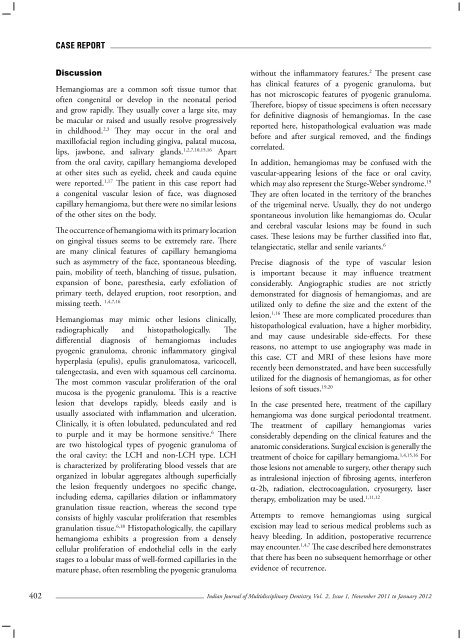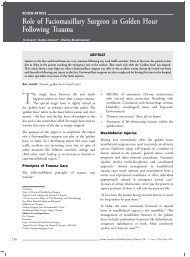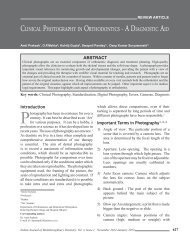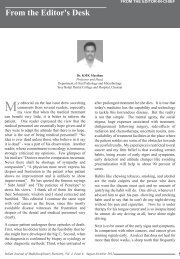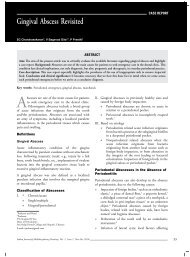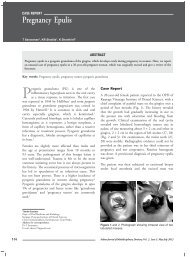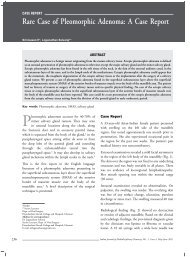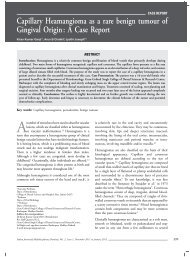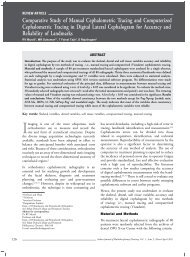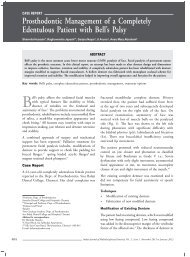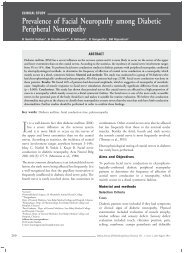Volume 2 - Issue 1 (Nov-Jan) - IJMD
Volume 2 - Issue 1 (Nov-Jan) - IJMD
Volume 2 - Issue 1 (Nov-Jan) - IJMD
Create successful ePaper yourself
Turn your PDF publications into a flip-book with our unique Google optimized e-Paper software.
Case ReportDiscussionHemangiomas are a common soft tissue tumor thatoften congenital or develop in the neonatal periodand grow rapidly. They usually cover a large site, maybe macular or raised and usually resolve progressivelyin childhood. 2,3 They may occur in the oral andmaxillofacial region including gingiva, palatal mucosa,lips, jawbone, and salivary glands. 1,2,7,10,15,16 Apartfrom the oral cavity, capillary hemangioma developedat other sites such as eyelid, cheek and cauda equinewere reported. 1,17 The patient in this case report hada congenital vascular lesion of face, was diagnosedcapillary hemangioma, but there were no similar lesionsof the other sites on the body.The occurrence of hemangioma with its primary locationon gingival tissues seems to be extremely rare. Thereare many clinical features of capillary hemangiomasuch as asymmetry of the face, spontaneous bleeding,pain, mobility of teeth, blanching of tissue, pulsation,expansion of bone, paresthesia, early exfoliation ofprimary teeth, delayed eruption, root resorption, andmissing teeth. 1,4,7,16Hemangiomas may mimic other lesions clinically,radiographically and histopathologically. Thedifferential diagnosis of hemangiomas includespyogenic granuloma, chronic inflammatory gingivalhyperplasia (epulis), epulis granulomatosa, varicocell,talengectasia, and even with squamous cell carcinoma.The most common vascular proliferation of the oralmucosa is the pyogenic granuloma. This is a reactivelesion that develops rapidly, bleeds easily and isusually associated with inflammation and ulceration.Clinically, it is often lobulated, pedunculated and redto purple and it may be hormone sensitive. 6 Thereare two histological types of pyogenic granuloma ofthe oral cavity: the LCH and non-LCH type. LCHis characterized by proliferating blood vessels that areorganized in lobular aggregates although superficiallythe lesion frequently undergoes no specific change,including edema, capillaries dilation or inflammatorygranulation tissue reaction, whereas the second typeconsists of highly vascular proliferation that resemblesgranulation tissue. 6,18 Histopathologically, the capillaryhemangioma exhibits a progression from a denselycellular proliferation of endothelial cells in the earlystages to a lobular mass of well-formed capillaries in themature phase, often resembling the pyogenic granulomawithout the inflammatory features. 2 The present casehas clinical features of a pyogenic granuloma, buthas not microscopic features of pyogenic granuloma.Therefore, biopsy of tissue specimens is often necessaryfor definitive diagnosis of hemangiomas. In the casereported here, histopathological evaluation was madebefore and after surgical removed, and the findingscorrelated.In addition, hemangiomas may be confused with thevascular-appearing lesions of the face or oral cavity,which may also represent the Sturge-Weber syndrome. 19They are often located in the territory of the branchesof the trigeminal nerve. Usually, they do not undergospontaneous involution like hemangiomas do. Ocularand cerebral vascular lesions may be found in suchcases. These lesions may be further classified into flat,telangiectatic, stellar and senile variants. 6Precise diagnosis of the type of vascular lesionis important because it may influence treatmentconsiderably. Angiographic studies are not strictlydemonstrated for diagnosis of hemangiomas, and areutilized only to define the size and the extent of thelesion. 1,16 These are more complicated procedures thanhistopathological evaluation, have a higher morbidity,and may cause undesirable side-effects. For thesereasons, no attempt to use angiography was made inthis case. CT and MRI of these lesions have morerecently been demonstrated, and have been successfullyutilized for the diagnosis of hemangiomas, as for otherlesions of soft tissues. 19,20In the case presented here, treatment of the capillaryhemangioma was done surgical periodontal treatment.The treatment of capillary hemangiomas variesconsiderably depending on the clinical features and theanatomic considerations. Surgical excision is generally thetreatment of choice for capillary hemangioma. 1,4,15,16 Forthose lesions not amenable to surgery, other therapy suchas intralesional injection of fibrosing agents, interferonα-2b, radiation, electrocoagulation, cryosurgery, lasertherapy, embolization may be used. 1,11,12Attempts to remove hemangiomas using surgicalexcision may lead to serious medical problems such asheavy bleeding. In addition, postoperative recurrencemay encounter. 1,4,7 The case described here demonstratesthat there has been no subsequent hemorrhage or otherevidence of recurrence.402Indian Journal of Multidisciplinary Dentistry, Vol. 2, <strong>Issue</strong> 1, <strong>Nov</strong>ember 2011 to <strong>Jan</strong>uary 2012


